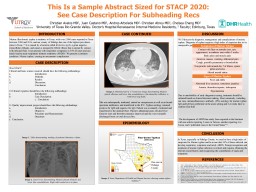

This Is a Sample Abstract Sized for STACP 2020 See Case Description For Subheading Recs Christian Avalos MD 1 Juan Castano MD 1 Andres Arboleda MD 1 Christian Abreu MD 1 Chelsea Chang MD ID: 1014903
Download Presentation The PPT/PDF document "She was subsequently intubated, started ..." is the property of its rightful owner. Permission is granted to download and print the materials on this web site for personal, non-commercial use only, and to display it on your personal computer provided you do not modify the materials and that you retain all copyright notices contained in the materials. By downloading content from our website, you accept the terms of this agreement.
1. She was subsequently intubated, started on vasopressors as well as on broad-spectrum antibiotics, and transferred to the ICU. Typhus serology returned positive for IgM and negative for IgG. Patient was eventually extubated and transferred to the medical floor. Patient’s abdominal pain, elevated liver function tests and thrombocytopenia improved and she was eventually discharged home on oral doxycycline. This Is a Sample Abstract Sized for STACP 2020: See Case Description For Subheading RecsChristian Avalos MD1, Juan Castano MD1, Andres Arboleda MD1, Christian Abreu MD1, Chelsea Chang MD21University of Texas Rio Grande Valley- Doctor’s Hospital Renaissance Internal Medicine Residents, 2 Faculty; Edinburg, TexasMurine (flea-borne) typhus is endemic in Texas, with over 2,800 cases reported in Texas between 2000 and 2016, and our county of Hidalgo has one of the highest prevalence rates in Texas. 10 It is caused by a bacteria called Rickettsia typhi, a gram negative intracellular obligate, and causes a nonspecific febrile illness that is spread by contact with infected fleas. It can present with respiratory symptoms in 30% of cases and can rarely lead to acute respiratory distress syndrome (ARDS)3. We present a common condition, Murine typhus, causing an uncommon complication.9For STACPClinical and basic science research should have the following subheadings:a. Introduction:b. Methods:c. Results:d. Discussion:Conclusion:10.Clinical vignettes should have the following subheadings:a. Introduction:b. Case Description:Conclusion:11.Quality improvement project should have the following subheadings:a. Introduction:b. Objective:c. Procedure and Measurements:d. Outcomes:Conclusion:We’ll discuss the diagnosis, management and complications of murine typhus. Diagnosis of typhus requires a high index of suspicion due to its nonspecific presentation. Due to unreliability of early diagnostic testing, treatment should be initiated based on clinical decision making. Most commonly, including our case, immunofluoresnce antibody (IFA) serology for murine typhus IgG and IgM are performed in the acute setting and 2-4 weeks later to confirm four-fold The development of ARDS has rarely been reported in the literature with one article reporting 2 cases in Taiwan, another reporting 6 in Korea, and 2 published cases in the United States2,3,5. In Texas, especially in Hidalgo County, we need to have a high index of suspicion for Murine typhus and be aware that 30% of those infected can develop respiratory symptoms and rarely ARDS. Prompt recognition and treatment of murine typhus infection is critical and requires obtaining the relevant social history and recognizing the constellation of signs and symptoms.Afzal Z, Kallumadanda S, Wang F, Hemmige V, Musher D. Acute Febrile Illness and Complications Due to Murine Typhus, Texas, USA,. Emerging Infectious Diseases. 2017;23(8):1268-1273. doi:10.3201/eid2308.161861.Chang K, Chen YH, Lee NY, et al. Murine typhus in southern Taiwan during 1992-2009. Am J Trop Med Hyg. 2012 Jul;87(1):141-7. doi: 10.4269/ajtmh.2012.11-0465.van der Vaart TW, van Thiel P, Juffermans NP, et al. Severe Murine Typhus with Pulmonary System Involvement. Emerging Infectious Diseases. 2014;20(8):1375-1377. doi:10.3201/eid2008.131421.Malheiro L, Ceia F, Alves J, et al. Severe interstitial pneumonia due to murine typhus in a patient returning from Bali. IDCases. 2017;9:17-20. doi:10.1016/j.idcr.2017.05.006.Ji Yeol Yoon et al. Murine Typhus as a Cause of Acute Respiratory Distress Syndrome in Endemic Area. Tuberc Respir Dis. 2002 Apr;52(4):367-374. Korean.Pieracci EG, Evert N, Drexler NA, et al. Fatal Flea-Borne Typhus in Texas: A Retrospective Case Series, 1985–2015. The American Journal of Tropical Medicine and Hygiene. 2017;96(5):1088-1093. doi:10.4269/ajtmh.16-0465.Sakamoto N, Nakamura-Uchiyama F, Kobayashi K, Takasaki T, Ogasawara Y, Ando S, Iwabuchi S, Ohnishi K. Severe murine typhus withINTRODUCTIONCASE DESCRIPTIONCASE CONTINUEDDISCUSSIONCONCLUSIONREFERENCESImage 2. Chest X-ray demonstrating bilateral pleural effusions and lower lobe consolidations. Right sided central ine is in place.Image 3. Abdominal/pelvic CT transverse image demonstrating bilateral pleural effusions and lower lobe consolidations with edema-like infiltrates in both lower lung fields.Image 1. Table demonstrating trending of pertinent laboratory valiues...EPIDEMIOLOGYImage 4. Texas Department of Health and Human Services showing murine typhus statistics.10Our case in Hidalgo CountySymptoms of Murine TyhpusContact with fleas or animals (rats, cats, oppposums) in endemic area within 2 weeksBody aches and muscle painAnorexia, nausea, vomiting, abdominal painCough, possibly pneumonia or bronchiolitisNon-pruritic rash around day 5 of illness, spares palms and solesAltered mental statusSigns of Murine TyphusFever and chillsAbnormal liver enzymes, sometimes jaundiceAnemia, thrombocytopenia, leukopeniaHyponatremia